 So you’re jamming with some friends and the time has come for you to bust into your next jaw dropping guitar solo.
So you’re jamming with some friends and the time has come for you to bust into your next jaw dropping guitar solo.
Or maybe band practice is soon approaching and it’s on you to come up with the riff to end all riffs that you will build your song around.
Wouldn’t it be great if there was a group of notes you could use that would not only sound great for that guitar solo but also provide you with an almost infinite resource for riff writing madness.
Well lucky for you my axe wielding friends such a group of notes does exist and it’s called the pentatonic scale.
In the following article I’ll show you the ins and outs of this incredibly useful sequence of notes.
Improve your guitar playing by downloading a copy of my Free Guitar Practice Routine Checklist and Planning Guide.
Table Of Contents
- What Is The Pentatonic Scale
- Playing The Pentatonic Scale on Guitar
- Pentatonic Scales on a Single String
- Pentatonic Scale Shapes
- Pentatonic Scale Patterns
- Pentatonic Scale Licks
- Diagonal Pentatonic Scale Shapes
- Improvising With the Pentatonic Scale
- The Pentatonic Scale and the Blues Scale
- The Pentatonic Scale and Movable Chord Shapes
- The Major-Minor Pentatonic Scale
- Conclusion
What Is the Pentatonic Scale
Pentatonic Scale Overview
The pentatonic scale is a very popular scale that is used in many different types of music such as rock, blues, country, pop, jazz, classical, etc.
The pentatonic scale is a 5 note scale hence the name pentatonic, penta is a latin term meaning 5 and tonic means tone or note.
Though the pentatonic scale is widely used in many modern forms of music, the pentatonic scale has been around for hundreds if not thousands of years.
The Major Pentatonic Scale
Other 5 note scales exist and can be very useful but when musicians talk about the pentatonic scale they are usually referring to this scale here:
C D E G A
This is a C major pentatonic scale and as with everything else in music there are 12 different major pentatonic scales, each starting on a different note of the musical alphabet.
The formula for a major pentatonic scale is:

You can think of it as a major scale without the 4th and 7th notes.

This is one of the reasons the pentatonic scale sounds so good in application, because it omits what tend to be the more dissonant notes from the major scale.
The extra space between the notes also adds a kind of open quality to the scale that helps it fit over a wide variety of chord progressions making it a useful scale for improvising.
The Minor Pentatonic Scale
The minor pentatonic scale shares the same group of notes as the major pentatonic scale when it starts on the 5th note of the major pentatonic scale (6th note of the major scale), the root of the relative minor.
So A minor pentatonic scale is:
A C D E G
As you can see these are exactly the same notes as in C major pentatonic scale with the only real difference being what note we focus on as the root note or tonal center.
In C major pentatonic scale the root note, or tonal center, is the note C and in A minor pentatonic scale the root note is the note A.
The formula for the minor pentatonic scale is:

You can think of a minor pentatonic scale as a natural minor scale without the 2nd and 6th notes.

Building The Pentatonic Scale From The Cycle Of Fifths
Another interesting way to construct the pentatonic scale is to see it from the perspective of the cycle of fifths.
The cycle of fifths is a system for looking at the relationships between the different notes and keys of the musical alphabet with each note being a perfect fifth apart.
Here is the cycle of fifths:

If you start at C and work clockwise around the cycle you get the notes C G D A E, again, each note being a perfect fifth apart.
Does this group of notes look familiar?
Well it should because if you rearrange the notes you’ll notice that these are exactly the notes of the C major and A minor pentatonic scales.
Playing The Pentatonic Scale On Guitar
We just discussed how the major and minor pentatonic scales are the same group of notes but with a different note acting as the root note or tonal center.
This fact will be useful for learning the pentatonic scale on the guitar.
One shape will be both the major pentatonic scale and the minor pentatonic scale, it’s just a matter of changing which note is acting as the root note.
Remember, the root note is a note other notes revolve around and resolve to.
In the diagrams throughout the article the major pentatonic scale root notes will be highlighted in yellow and the minor pentatonic scale root notes will be highlighted in green unless otherwise noted.
There are 3 practical ways we will organize the pentatonic scale on the guitar:
- Linear along a single string
- Vertically across the strings in a shape or position
- Diagonally across the strings by connecting shapes and positions together
For the purpose of this lesson a shape will refer to the layout of the notes on the guitar neck and a position will refer to the note the shape starts on relative to where that note is in the scale.
Keep in mind every one of these shapes will be the same no matter what key you’re in as all shapes are movable along the guitar neck.
So for example if you wanted to move from Shape 1 in A minor pentatonic scale to Shape 1 in B minor pentatonic scale you just shift the entire shape up 2 frets from the 5th fret to the 7th fret.
Pentatonic Scales On A Single String
When a scale is played along a single string we call this a linear scale because all the notes line up one after another along the guitar string.
Linear scales are a great way to visualize a scale on the guitar because you can clearly see the distances or intervals between each note in the scale.
Remember all major root notes are highlighted in yellow and all minor root notes are highlighted in green.
The pentatonic scale along the low E string provides the starting notes for each shape of the pentatonic scale that we’ll be looking at in the following section.
All examples are in the key of C major/A minor so if you wanted to change keys you would just have to shift the notes up or down the neck.
High E String


B String


G String


D String


A String


Low E String


To help get the sound and feel of the linear pentatonic scales into your head and hands try playing them over this vi IV V iii backing track in the key of C major.
Pentatonic Scale Shapes
Once you’ve become familiar with the pentatonic scale along each string it’s time to start learning the different shapes for them on the guitar fretboard.
There are 5 Shapes for the pentatonic scale and each shape contains both major and minor pentatonic scales.
Remember that the major and minor pentatonic scales are the same group of notes but with a different note acting as the root note or tonal center.
All major root notes are highlighted in yellow and all minor root notes are highlighted in green.
Fingering for each shape can be thought of in 1-3s and 1-4s and this is also a great way to visualize the shapes of the pentatonic scale on the fretboard.
There are three consecutive 1-3s and two consecutive 1-4s in each shape plus an extra depending on which pair of notes lands on the outside E strings.
Each shape shares a set of notes with the shape before and after it.
As you can see in the following diagram, the higher fret notes on each string become the lower fret notes on each string in the next shape.
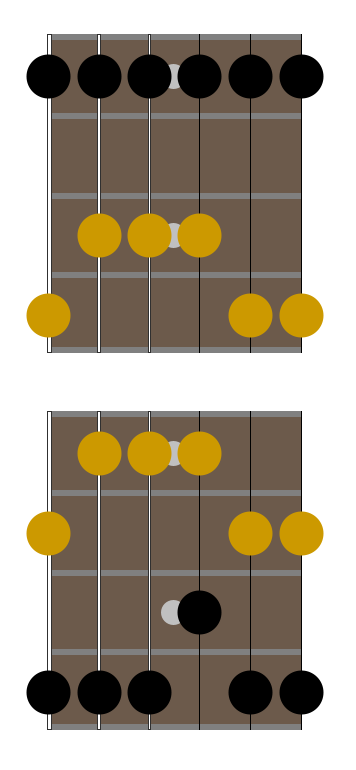
As a reminder, the position of each scale is numbered by scale degree. For example, the root position of A minor pentatonic starts on A and Position 4 of C major pentatonic starts on G.
Shape 1 – Minor Pentatonic Scale Root Position and Major Pentatonic Scale Position 5
Shape 1 is the root position of the minor pentatonic scale and the 5th position of the major pentatonic scale.
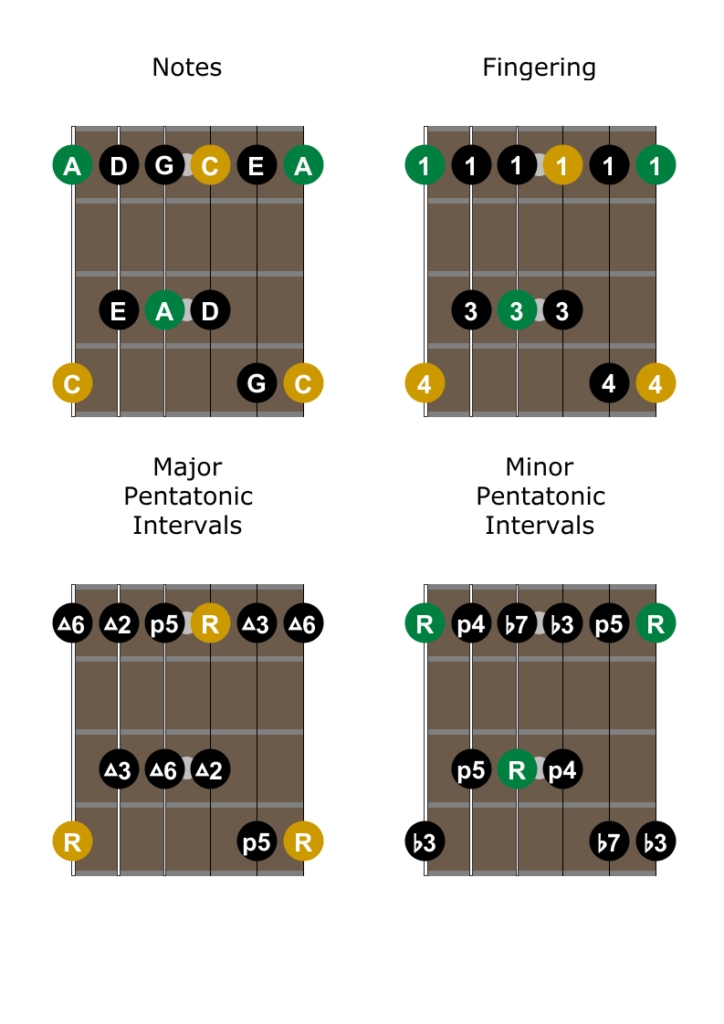

Shape 2 – Minor Pentatonic Scale Position 2 and Major Pentatonic Scale Root Position
Shape 2 is the 2nd position of the minor pentatonic scale and the root position of the major pentatonic scale.
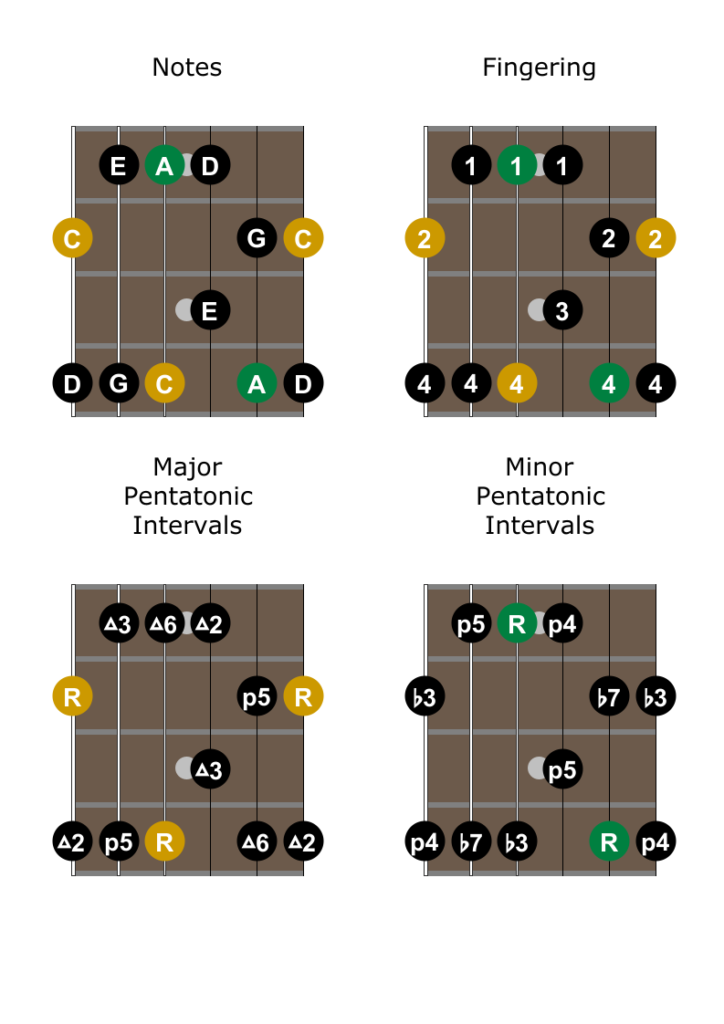

Shape 3 – Minor Pentatonic Scale Position 3 and Major Pentatonic Scale Position 2
Shape 3 is the 3rd position of the minor pentatonic scale and the 2nd position of the major pentatonic scale.


Shape 4 – Minor Pentatonic Scale Position 4 and Major Pentatonic Scale Position 3
Shape 4 is the 4th position of the minor pentatonic scale and the 3rd position of the major pentatonic scale.
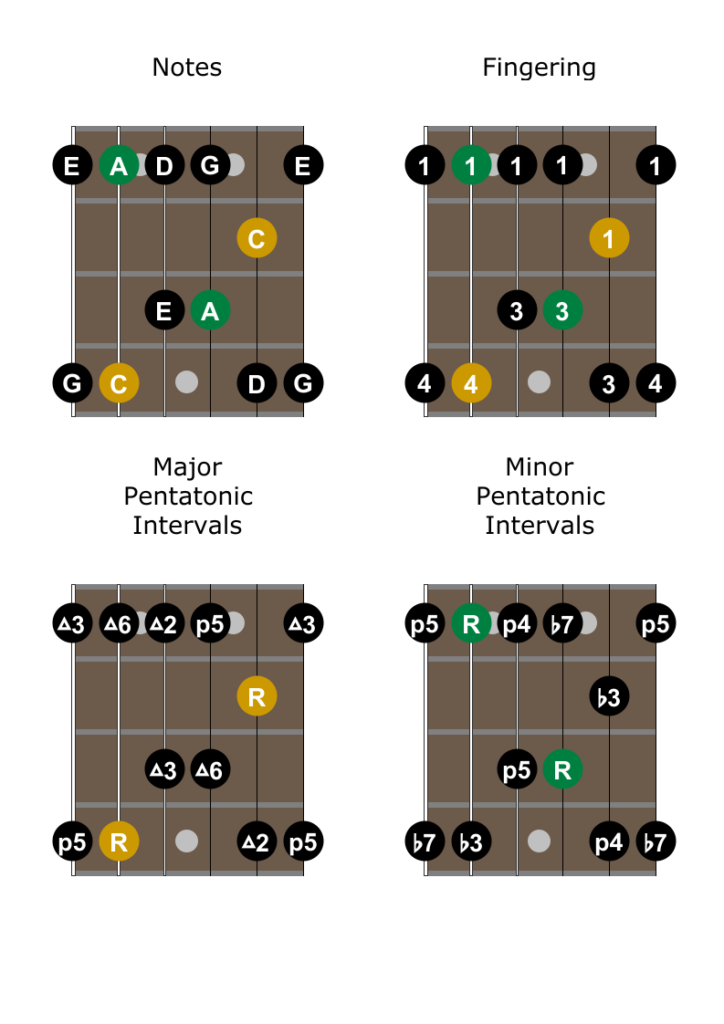

Shape 5 – Minor Pentatonic Scale Position 5 and Major Pentatonic Scale Position 4
Shape 5 is the 5th position of the minor pentatonic scale and the 4th position of the major pentatonic scale.


To help get the sound and feel of each pentatonic scale shape into your head and hands try playing them over this I V vi IV backing track in the key of C major.
Pentatonic Scale Patterns
The next step after you’ve learned a pentatonic scale shape is to start working that shape in different patterns, not just ascending and descending, to really help you get it under your fingers.
Here are just a few patterns to get you started and though each pattern is only shown on pentatonic shape 1, all patterns can be applied to all 5 pentatonic shapes.
Try practicing each pattern with a metronome or over the backing track provided below the tabs.
Once you’ve mastered the patterns below try coming up with some of your own to try with the different scale shapes.
Pentatonic Scale Pattern 1 – String Skipper
Pentatonic Scale Pattern 2 – 3 Note Sequence
Pentatonic Scale Pattern 3 – Low Low High High
Pentatonic Scale Pattern 4 – Roundabout
Pentatonic Scale Pattern 5 – Figure 8

Here is a I ii IV V backing track in the key of C major for you to practice the patterns over.
Pentatonic Scale Licks
Here are 5 licks from the pentatonic scale for you to practice to help you transition into making the pentatonic scales sound more musical.
Each Lick is from a different pentatonic scale shape. For example, Lick 1 is from Shape 1 and Lick 2 is from Shape 2.
Pentatonic Scale Lick 1
Pentatonic Scale Lick 2
Pentatonic Scale Lick 3
Pentatonic Scale Lick 4
Pentatonic Scale Lick 5
Try playing the licks over this vi IV I V backing track in the key of C major to see if you can make them fit in a musical way.
Diagonal Pentatonic Scale Shapes
After you’re comfortable playing within each shape of the pentatonic scale the next step is to connect the shapes together to form diagonal pentatonic shapes on the guitar.
Practicing diagonal pentatonic scale shapes will assist you in breaking out of playing only individual shapes by helping you move seamlessly through the shapes along the fretboard.
Learning these diagonal shapes will greatly improve your perspective of the pentatonic scale on the guitar.
Diagonal Pentatonic Scale Shape 1
Diagonal Pentatonic Scale Shape 2
Diagonal Pentatonic Scale Shape 3
Diagonal Pentatonic Scale Shape 4
Diagonal Pentatonic Scale Shape 5
Try playing the diagonal shapes over this I IV V IV backing track in the key of C major to gain a larger perspective of the pentatonic scale on the guitar fretboard.
Improvising With The Pentatonic Scale
Now that you’ve become familiar with the pentatonic scale on the fretboard let’s discuss how to use it.
First we’ll look at using the pentatonic scale over diatonic chords and chord progressions and then over a standard 12 bar blues progression.
The Pentatonic Scale over Chord Progressions
Take a look at the notes of the C major scale:
C D E F G A B C
Now take a look at the notes of these three pentatonic scales:
C Major (A minor) Pentatonic Scale: C D E G A
F Major (D minor) Pentatonic Scale: F G A C D
G Major (E minor) Pentatonic Scale: G A B D E
The C major scale includes the notes of all three of these pentatonic scales.
This means that if you are improvising over a chord progression in the key of C you can use either C major, F Major, or G Major pentatonic scale.
They will each have their own sound but you will probably find that the pentatonic scale built from the root note of the major scale will fit best over most diatonic chord progressions.
Now let’s compare each of these pentatonic scales to the specific chords in the key of C.
Here are the triads (three note chords) in the key of C:

C major and A minor pentatonic scale include all the notes of the C major chord and the A minor chord.
F major and D minor pentatonic scale include all the notes of the F major chord and the D minor chord.
G major and E minor pentatonic scale include all the notes of the G major chord and the E minor chord.
Here’s a summary:
- I IV and V Chords = major pentatonic scale from root note
- ii iii and vi Chords = minor pentatonic scale from root note
If you’d like to better outline the harmonic structure of the chord progression you’re improvising over then try playing the pentatonic scale that matches each chord.
A vi IV I V chord progression in the key of C is Am F C G.
Here is a backing track of this chord progression for you to practice over.
Try playing the C major (A minor) pentatonic scale over the entire chord progression.
Then try playing only A minor pentatonic scale over the Am chord, F major pentatonic scale over the F chord, C major pentatonic scale over the C chord and G major pentatonic scale over the G chord.
Listen for how switching pentatonic scales better follows the chords in the chord progression.
The pentatonic scales also include chord extensions in addition to the triad notes.
The major pentatonic scale includes the 9th and the 6th in addition to the root, 3rd and 5th of the major triad.
The minor pentatonic scale includes the flat 7th and the 11th in addition to the root, flat 3rd and 5th of the minor triad.
These notes can be used to bring out the sounds of these different chords.
The Pentatonic Scale Over The Blues
The pentatonic scale is a very common scale to use while improvising over blues music.
The standard 12 bar blues consists of three chords, I7 IV7 V7, played over 12 measures.
Here is an example in the key of A with A7 = I7, D7 = IV7 and E7 = V7.

Take a listen to the 12 bar blues in the key of A with the following backing track.
You would use A minor pentatonic scale over this 12 bar blues in the key of A to get a bluesy sound.
A blues sound can be thought of as minor over major, as in a minor scale over major chords.
The dominant 7th chords are just major triads with a flat 7th so playing the minor pentatonic scale over them brings out the blues sound.
That said, you can also play the A major pentatonic scale over this 12 bar blues in the key of A to get a very different sound if that’s what you’re after.
Below we’ll look at how the pentatonic scale relates to the blues scale to help bring out an even bluesier sound.
The Pentatonic Scale and the Blues Scale
The pentatonic scale and the blues scale are very closely related with the only difference between the scales being the addition of one note, the flat 3rd in the major pentatonic scale or the flat 5th in the minor pentatonic scale depending on how you look at it.
For example, the A blues scale is the A minor pentatonic scale with the flat 5th added to it.
When playing over the 12 bar blues in the key of A you would play the A Blues Scale.
Below are shapes and tabs for the blues scale on guitar.
Blues Scale Shape 1
Blues Scale Shape 2
Blues Scale Shape 3
Blues Scale Shape 4
Blues Scale Shape 5


Here is the same 12 bar blues backing track as above for you to try practicing the blues scale shapes over.
The Pentatonic Scale And Movable Chord Shapes
Both major and minor pentatonic scales include all the chord tones of their related major and minor triads so within each shape are movable chord shapes for each major and minor triad.
Try playing the chord from each shape followed by the scale, listening for how the chord sounds in relation to the entire group of notes.
Pentatonic Scale Shape 1 Chords
Major Chord Tones
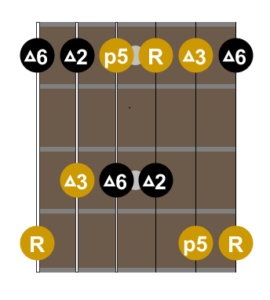
Minor Chord Tones
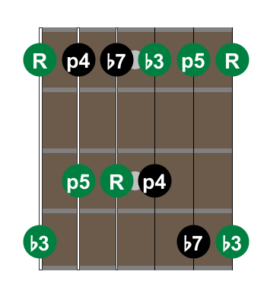
Movable Major Chord Fingering
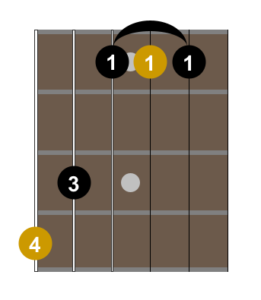
Movable Minor Chord Fingering
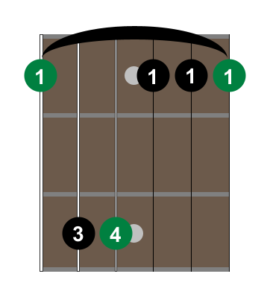
Pentatonic Scale Shape 2 Chords
Major Chord Tones
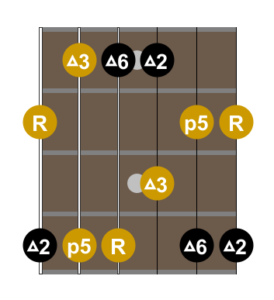
Minor Chord Tones
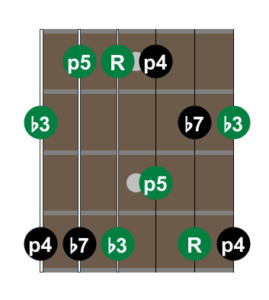
Movable Major Chord
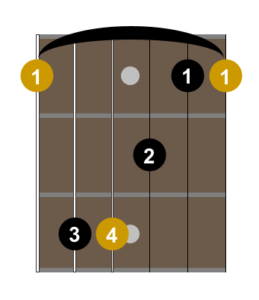
Movable Minor Chord
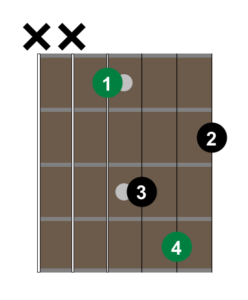
Pentatonic Scale Shape 3 Chords
Major Chord Tones

Minor Chord Tones

Movable Major Shape

Movable Minor Shape
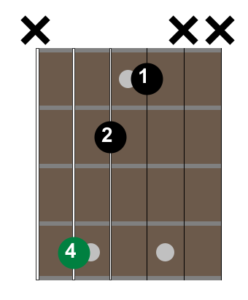
Pentatonic Scale Shape 4 Chords
Major Chord Tones

Minor Chord Tones

Movable Major Chord
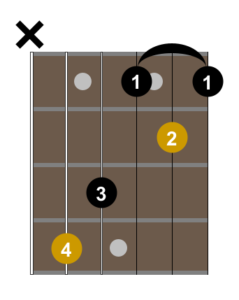
Movable Minor Chord

Pentatonic Scale Shape 5 Chords
Major Chord Tones
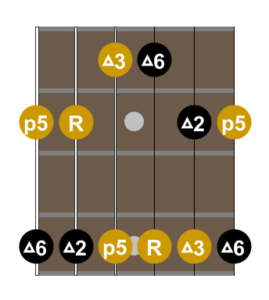
Minor Chord Tones

Movable Major Chord

Movable Minor Shape
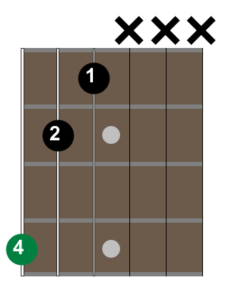
The Major-Minor Pentatonic Scale
In certain situations you can use both the major and minor pentatonic scales of a specific root note.
To help bring an awareness as to where the notes of both major and minor pentatonic scales are in relation to a specific root note we can connect the major and minor pentatonic scales to form the major-minor pentatonic scale.
Here are shapes showing both major and minor pentatonic scales with the same root note combined into one scale.
The notes in red are notes common to both the major and minor pentatonic scale. The notes in yellow are from the major pentatonic scale and the notes in green are from the minor pentatonic scale.
Major-Minor Pentatonic Scale Shape 1
Major-Minor Pentatonic Scale Shape 2
Major-Minor Pentatonic Scale Shape 3
Major-Minor Pentatonic Scale Shape 4
Major-Minor Pentatonic Scale Shape 5
Conclusion
Hopefully this introduction to the pentatonic scale has equipped you with some of the skills necessary for the next time you need to write that killer riff or whip out that awe inspiring solo.
Though there are other scales you should learn on the guitar the pentatonic scale is a great first choice for improvisation, riff writing, soloing, melodies, etc.
Now go have some fun jamming and making music with the pentatonic scale!

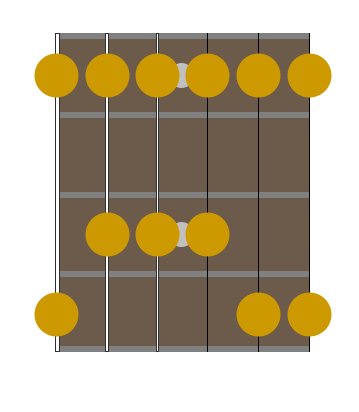

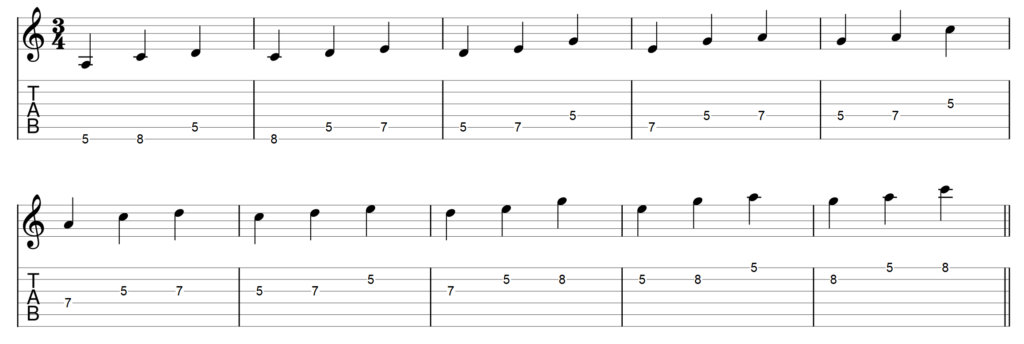















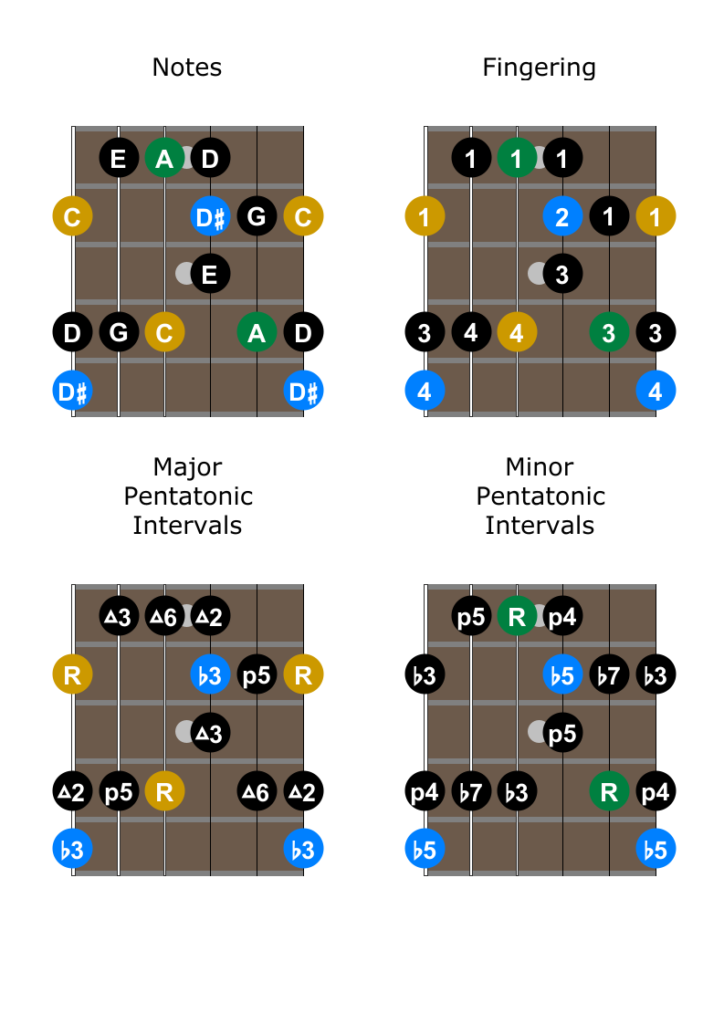



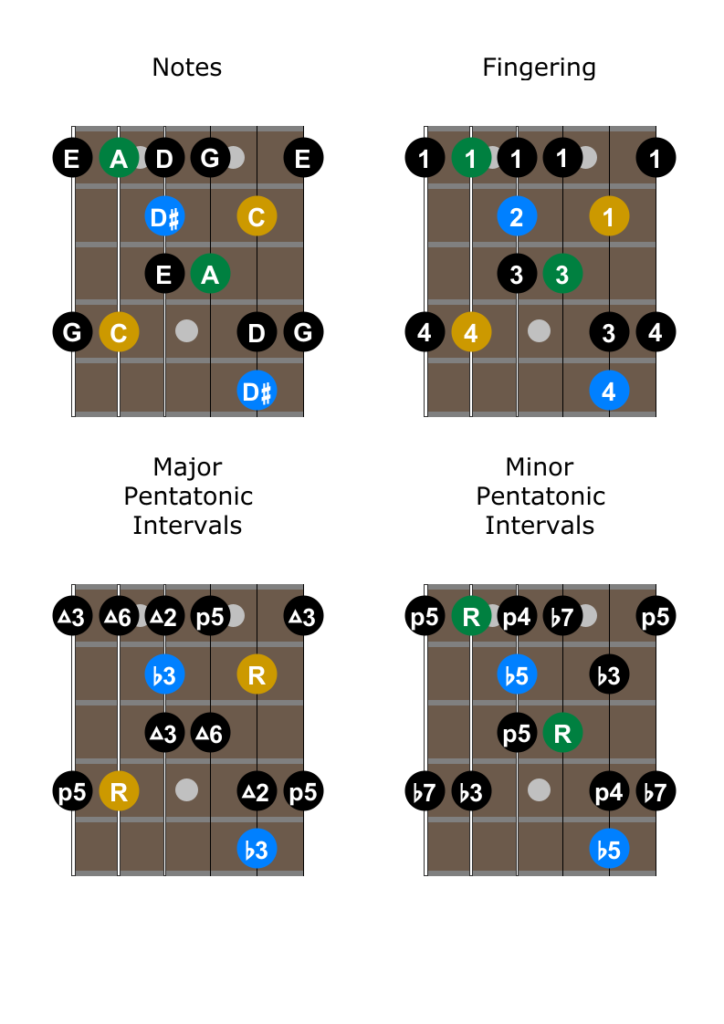



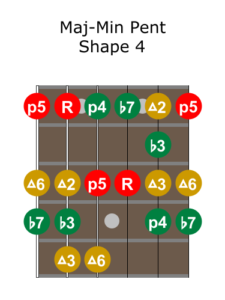




No Comments